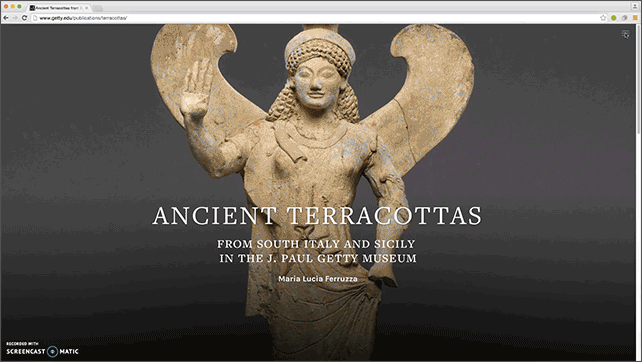Getty Publications has
inaugurated a new series of open-access collection catalogues
available online, as downloadable ebooks, and in print
Getty Publications has just launched two born-digital collection
catalogues exploring groups of ancient objects in the Museum’s
collection:
Ancient Terracottas from South Italy and Sicily and
Roman Mosaics.
These two titles inaugurate a series of dynamic, user-friendly,
technologically robust digital publications focusing on the Getty
collections that complement our many distinguished print publications.
Terracottas and Mosaics
The
Terracottas catalogue, by Italian scholar Maria Lucia
Ferruzza, highlights sixty notable objects and includes an annotated
reference by Museum curator Claire L. Lyons to the more than 1,000 other
such works in the collection.
The
Roman Mosaics catalogue documents the Museum’s complete collection of these works and is published in conjunction with the exhibition
Roman Mosaics across the Empire,
now on view at the Villa. Curator Alexis Belis organized the exhibition
and wrote the catalogue, which also has contributions by other
scholars.
The
new Roman Mosaics online catalogue includes interactive maps,
full-width zoomable images, and embedded glossary terms and reference
illustrations.
Why Digital Catalogues?
Following the Getty Foundation’s successful
Online Scholarly Catalogue Initiative
(OSCI), more and more museums have been looking to digital formats for
their collection catalogues. Digital formats allow for greater access,
more flexibility, and interactive features not possible in print books.
Several museums that were part of the OSCI project are moving forward
with yet more digital catalogues. Other museums have joined these early
pioneers in exploring an expanding range of ways to make scholarly
research on their collections available online. The Getty itself made an
early foray into online publishing with
a catalogue on ancient ambers, which was released in 2012. In short, the field is embracing digital publications, and so are we.
What’s Inside?
Both publications offer features you might expect, like zoomable
high-resolution images and interactive maps. But beyond these more
obvious, splashy features are a number of quieter features that we hope
will make a long-term contribution to digital publishing in the
humanities.
An important part of our work at the Getty is to research our
collections and disseminate information about them as broadly as
possible. This content should be easy to find and should be preserved
over the long term. But this seemingly simple mandate is actually quite
complex, raising questions such as:
- How are digital books found by readers when they live outside the traditional distribution stream, such as libraries?
- How can an online book last decades or more, when the average lifespan for a website is more often measured in months?
- What happens to a digital book when platforms and technologies inevitably change?
To address these questions, the team at Getty Publications built in four key features:
- Each of these catalogues is published in multiple formats.
While the primary edition is online, you can also download PDFs, ebooks
for your Kindle or iPad, and image and data sets to use in your
research and teaching. And for readers who prefer print, paperback
copies are also available.
- The content remains in a plain-text format and is fully accessible at the project repository (GitHub) for each publication.
- Each publication features a permanent URL, and any
revisions made are carefully documented so researchers can feel
comfortable citing the work, knowing that their citations will be fully
verifiable down the road.
- These publications are issued under a Creative Commons license, continuing our efforts to make information available as widely as possible.
I hope you’ll explore the
Terracottas and
Roman Mosaics
catalogues online, or will download them to dig into their rich content
at your leisure. Look for more online publications in the coming months
as our efforts continue!
Readers
can dynamically search and sort among the sixty objects in the
Terracottas online catalogue, view artworks in detail, and view select
objects in full 360-degree rotation.








No comments:
Post a Comment